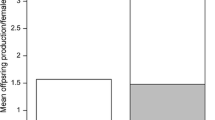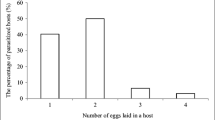Abstract
Environmental pressures are expected to favour organisms that optimally allocate metabolic resources to reproduction and survival. We studied the resource allocation strategies and the associated tradeoffs in the parasitoid wasp Venturia canescens, and their adaptation to the characteristics of the environment. In this species, individuals of two reproductive modes coexist in the same geographical locations, but they mainly occur in distinct habitats. Thelytokous (asexual) wasps are mostly found in anthropogenic habitats, where hosts tend to aggregate and food is absent. Arrhenotokous (sexual) wasps are exclusively found in natural habitats, where hosts are scattered and food is present. We analysed (1) the quantity of energy stored during ontogeny, (2) the tradeoff between reproduction and survival, by measuring egg load and longevity and (3) the host patch exploitation behaviour of the wasps at emergence. Arrhenotokous wasps emerged with more metabolic resources than thelytokous ones, especially glycogen, a nutrient that could be used for flying in search of hosts and/or food. Thelytokous wasps allocated more energy than arrhenotokous wasps to egg production: this would allow them to parasitize more hosts. The tradeoff between egg production and longevity was not revealed within reproductive modes, but when comparing them. At emergence, arrhenotokous wasps tended to exploit host patches less thoroughly than thelytokous wasps, suggesting that by leaving the host patch, they search for food. The results clearly showed adaptations to the characteristics of habitats preferentially inhabited by the two reproductive modes, and suggested a mechanism that facilitates their coexistence in natural conditions.



Similar content being viewed by others
References
Ahmad T (1936) The influence of ecological factors on the Mediterranean flour moth, Ephestia kuehniella, and its parasite, Nemeritis canescens. J Anim Ecol 5:67–93
Amat I (2004) Coexistence de la reproduction sexuée et asexuée chez l’hyménoptère parasitoïde Venturia canescens: aspects comportementaux et écologiques. Dissertation, Université Claude Bernard Lyon 1
Amat I, Bernstein C, van Alphen JJM (2003) Does a deletion in a virus-like particle protein have pleiotropic effects on the reproductive biology of a parasitoid wasp? J Insect Physiol 49:1183–1188
Amat I, Castelo M, Desouhant E, Bernstein C (2006) The influence of temperature and host availability on the host exploitation strategies of sexual and asexual parasitic wasps of the same species. Oecologia 148:153–161
Beling I (1932) Zur Biologie von Nemeritis canescens Grav. (Hymen. Ophion). Z Angew Entomol 19:223–249
Bernstein C, Heizmann A, Desouhant E (2002) Intraspecific competition between healthy and parasited hosts in a host-parasitoid system: consequences for life-history traits. Ecol Entomol 27:415–423
Beukeboom LW (2001) Single-locus complementary sex determination in the Ichneumonid Venturia canescens (Gravenhorst) (Hymenoptera). Neth J Zool 51:1–15
Beukeboom LW, Driessen G, Luckerhoff L, Bernstein C, Lapchin L, van Alphen JJM (1999) Distribution and relatedness of sexual and asexual Venturia canescens (Hymenoptera). Proc Sect Exp Appl Entomol 10:23–28
Boggs CL (1997) Reproductive allocation from reserves and income in butterfly species with differing adult diets. Ecology 78:181–191
Casas J, Driessen G, Mandon N, Wielaard S, Desouhant E, van Alphen JJM, Lapchin L, Rivero A, Christides JP, Bernstein C (2003) Energy dynamics in a parasitoid foraging in the wild. J Anim Ecol 72:691–697
Casas J, Pincebourde S, Mandon N, Vannier F, Poujol R, Giron D (2005) Lifetime nutrient dynamics reveal simultaneous capital and income breeding in a parasitoid. Ecology 86:545–554
Chessel D, Dufour AB, Thioulouse J (2004) The ade4 package-I: One-table methods. R News 4:5–10
Corbet SA (1968) The influence of Ephestia kuehniella on the development of its parasite Nemeritis canescens. J Exp Biol 48:291–304
Corbet SA (1971) Mandibular gland secretion of larvae of the flour moth, Anagasta kuehniella, contains an epideictic pheromone and elicits oviposition movements in a hymenopteran parasite. Nature 232:481–484
Desouhant E, Driessen G, Amat I, Bernstein C (2005) Host and food searching in a parasitic wasp Venturia canescens: a trade-off between current and future reproduction? Anim Behav 70:145–152
Desouhant E, Driessen G, Lapchin L, Wielaard S, Bernstein C (2003) Dispersal between host population in field conditions: navigation rules in the parasitoid Venturia canescens. Ecol Entomol 28:257–267
Driessen G, Bernstein C (1999) Patch departure mechanisms and optimal host exploitation in an insect parasitoid. J Anim Ecol 68:445–459
Eliopoulos PA, Harvey JA, Athanassiou CG, Stathas GJ (2003) Effect of biotic and abiotic factors on reproductive parameters of the synovigenic endoparasitoid Venturia canescens. Physiol Entomol 28:268–275
Ellers J, Sevenster JG, Driessen G (2000) Egg load evolution in parasitoids. Am Nat 156:650–665
Ellers J, van Alphen JJM (1997) Life history evolution in Asobara tabida: plasticity in allocation of fat reserves to survival and reproduction. J Evol Biol 10:771–785
Ellers J, van Alphen JJM, Sevenster JG (1998) A field study of size-fitness relationships in the parasitoid Asobara tabida. J Anim Ecol 67:318–324
Giron D, Casas J (2003) Lipogenesis in an adult parasitic wasp. J Insect Physiol 49:141–147
Harrison JF, Roberts SP (2000) Flight respiration and energetics. Annu Rev Physiol 62:179–205
Harvey JA, Harvey IF, Thompson DJ (1994) Flexible larval growth allows use of a range of host sizes by a parasitoid wasp. Ecology 75:1420–1428
Harvey JA, Harvey IF, Thompson DJ (1995) The effect of host nutrition on growth and development of the parasitoid wasp Venturia canescens. Entomol Exp Appl 75:213–220
Harvey JA, Harvey IF, Thompson DJ (2001) Lifetime reproductive success in the solitary endoparasitoid, Venturia canescens. J Insect Behav 14:573–593
Harvey JA, Vet LEM (1997) Venturia canescens parasitizing Galleria mellonella and Anagasta kuehniella: differing suitability of two hosts with highly variable growth potential. Entomol Exp Appl 84:93–100
Hastings A (1980) Disturbance, coexistence, history, and competition for space. Theor Popul Biol 18:363–373
Ihaka R, Gentleman R (1996) R: a language for data analysis and graphics. J Comput Graph Stat 5:299–314
Jervis MA, Boggs CL, Ferns PN (2005) Egg maturation strategy and its associated trade-offs: a synthesis focusing on Lepidoptera. Ecol Entomol 30:359–375
Kneitel M, Chase JM (2004) Trade-offs in community ecology: linking spatial scales and species coexistence. Ecology Lett 7:69–80
Lane SD, Mills NJ (2003) Intraspecific competition and density dependance in an Ephestia kuehniella—Venturia canescens laboratory system. Oikos 101:578–590
Levins R, Culver D (1971) Regional coexistence of species and competition between rare species. Proc Natl Acad Sci USA 68:1246–1248
Li D, Zhao Z, Roberts H, Schneider MV, Theopold U, Schmidt O (2003) Genetic analysis of two distinct reproductive strategies in sexual and asexual field populations of an endoparasitic wasp, Venturia canescens. Heredity 90:291–297
Maynard Smith J (1978) The evolution of sex. Cambridge University Press, London
Rivero A, Casas J (1999) Incorporating physiology into parasitoid behavioural ecology: the allocation of nutritional resources. Res Popul Ecol 41:39–45
Roff DA (1992) The evolution of life histories: theory and analysis. Chapman & Hall, New York
Roberts HLS, Schmidt O (2004) Lifetime egg maturation by host-deprived Venturia canescens. J Insect Physiol 50:195–202
Roberts HLS, Trüe O, Schmidt O (2004) The development of the endoparasitoid wasp Venturia canescens in superparasited Ephestia kuehniella. J Insect Physiol 50:839–846
Rogers DJ (1972) The ichneumon wasp Venturia canescens: oviposition and avoidance of superparasitism. Entomol Exp Appl 15:190–194
Rosenheim JA (1996) An evolutionary argument for egg limitation. Evolution 50:2089–2094
Salt G (1976) The hosts of Nemeritis canescens, a problem in the host specificity of insect parasitoids. Ecol Entomol 1:63–67
Schneider MV (2003) Modes of reproduction in the solitary parasitoid wasp Venturia canescens. Dissertation, Leiden University
Schneider MV, Beukeboom LW, Driessen G, Lapchin L, Bernstein C, van Alphen JJM (2002) Geographical distribution and genetic relatedness of sympatrical thelytokous and arrhenotokous populations of the parasitoid Venturia canescens (Hymenoptera). J Evol Biol 15:191–200
Sevenster JG, Ellers J, Driessen G (1998) An evolutionary argument for time limitation. Evolution 52:1241–1244
Sirot E, Bernstein C (1996) Time sharing between host searching and food searching in parasitoids: state-dependent optimal strategies. Behav Ecol 7:189–194
Stearns SC (1992) The evolution of life histories. Oxford University Press, Oxford
Suarez RK, Darveau CA, Welch KC, O’Brien DM, Roubik DW, Hochachka PW (2005) Energy metabolism in orchid bee flight muscles: carbohydrates fuels all. J Exp Biol 208:3573–3579
Tenhumberg B, Siekmann G, Keller MA (2006) Optimal time allocation in parasitic wasps searching for hosts and food. Oikos 113:121–131
Thiel A, Driessen G, Hoffmeister TS (2006) Different habitats, different habits? response to foraging information in the parasitic wasp Venturia canescens. Behav Ecol Sociobiol 59:614–623
Tilman D, Lehman CL, Yin C (1997) Habitat destruction, dispersal, and deterministic extinction in competitive communities. Am Nat 149:407–435
Tomassone R, Danzard M, Daudin JJ, Masson JP (1988) Discrimination et classement. Masson, Paris
Trudeau D, Gordon DM (1989) Factors determining the functional response of the parasitoid Venturia canescens. Entomol Exp Appl 50:3–6
van Alphen JJM, Bernstein C, Driessen G (2003) Information acquisition and time allocation in insect parasitoids. TREE 18:81–87
van Handel E (1985a) Rapid determination of total lipids in mosquitoes. J Am Mosq Control Assoc 1:302–304
van Handel E (1985b) Rapid determination of glycogen and sugars in mosquitoes. J Am Mosq Control Assoc 1:299–301
van Handel E, Day JF (1988) Assay of lipids, glycogen and sugars in individual mosquitoes: correlations with length in field-collected Aedes vexans. J Am Mosq Control Assoc 4:549–550
van Handel E, Day JF (1990) Nectar-feeding habits of Aedes taeniorhynchus. J Am Mosq Control Assoc 6:270–273
van Noordwijk AJ, de Jong G (1986) Acquisition and allocation of resources: their influence on variation in life history tactics. Am Nat 128:137–142
van Wilgenburg E, Driessen G, Beukeboom LW (2006) Single locus complementary sex determination in Hymenoptera: an “unintelligent” design? Front Zool 3:1
Vogt JT, Appel AG, West MS (2000) Flight energetics and dispersal capability of the fire ant, Solenopsis invicta Buren. J Insect Physiol 46:697–707
Waage JK (1979) Foraging for patchily-distributed hosts by the parasitoid Nemeritis canescens. J Anim Ecol 48:353–371
Acknowledgements
We are grateful to Annie Heizmann and Patricia Gibert for their help on technical aspects of this work. We would like to thank Isabelle Amat, Marie-Claude Venner, David Giron, Mark Jervis, Jacques van Alphen, Jérôme Casas and two anonymous referees for their most helpful comments on earlier drafts of the manuscript.
Author information
Authors and Affiliations
Corresponding author
Rights and permissions
About this article
Cite this article
Pelosse, P., Bernstein, C. & Desouhant, E. Differential energy allocation as an adaptation to different habitats in the parasitic wasp Venturia canescens . Evol Ecol 21, 669–685 (2007). https://doi.org/10.1007/s10682-006-9145-5
Received:
Accepted:
Published:
Issue Date:
DOI: https://doi.org/10.1007/s10682-006-9145-5




